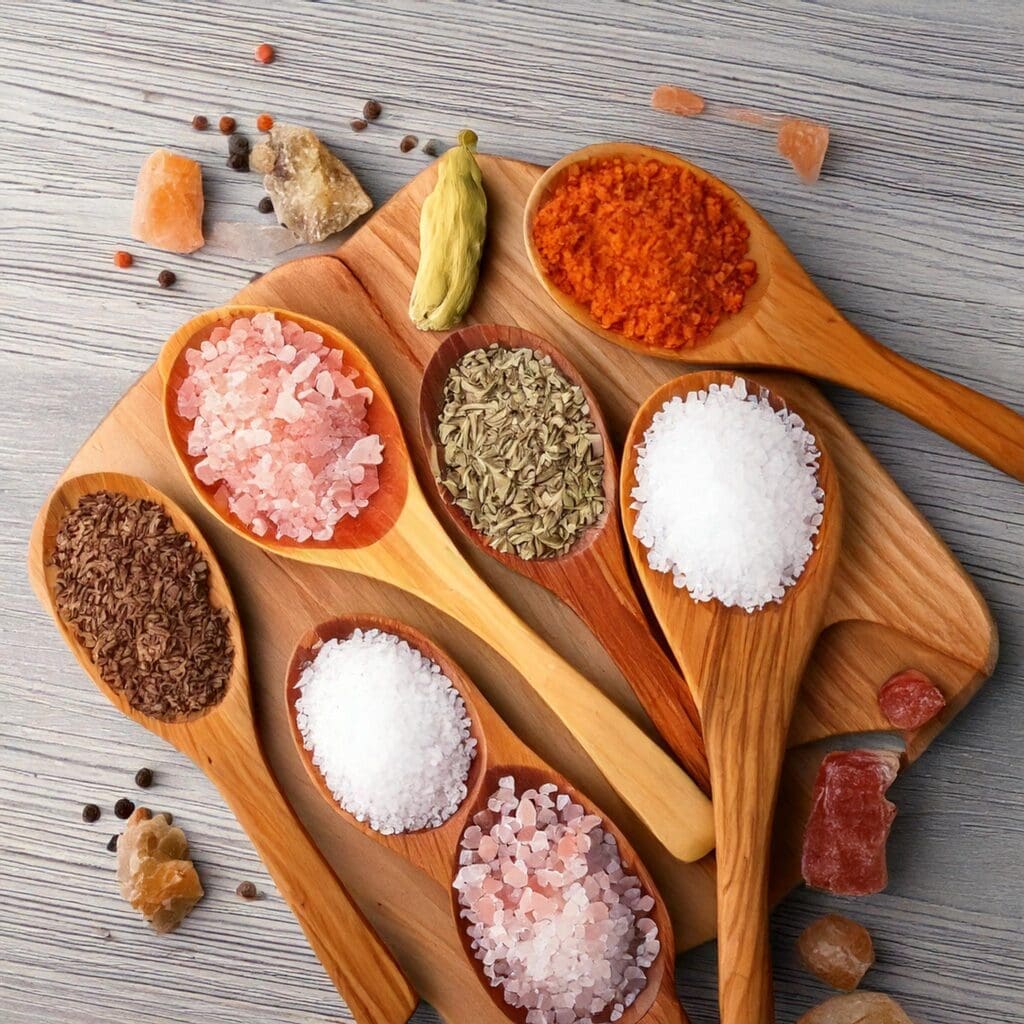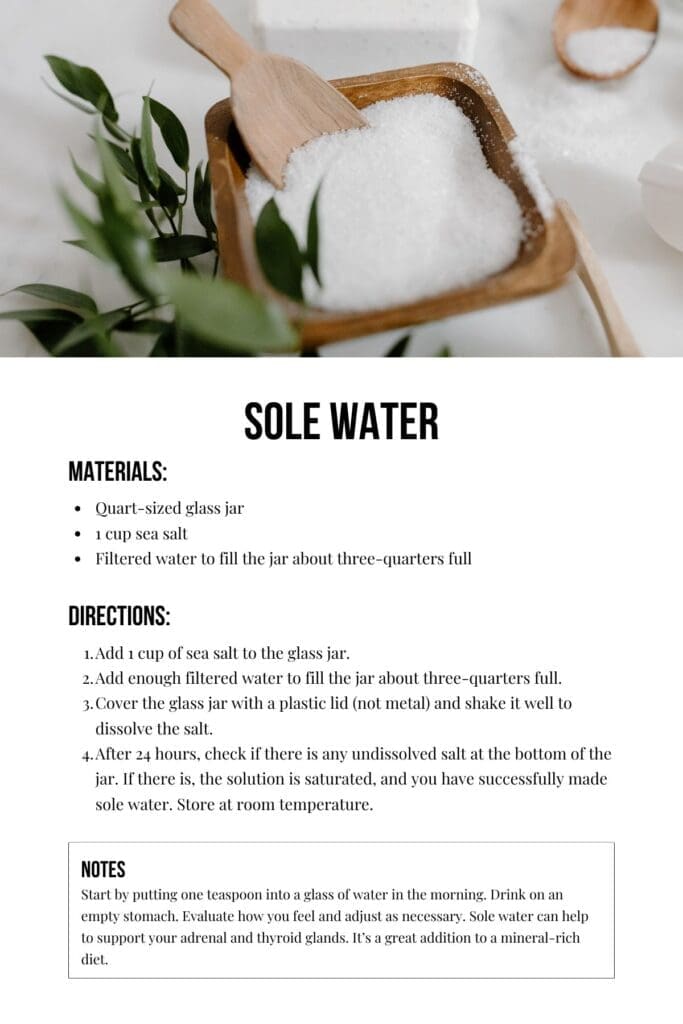Is Pink Himalayan Salt All It's Cracked Up to Be?
When it comes to hydration, we often think of drinking plain water, sports drinks, or even flavored water. But have you ever considered adding unrefined sea salt to your water? Not only can it add a delicious salty flavor, but it also provides a range of health benefits that you may not have known about. However, is pink Himalayan salt the best option?! If not, what is?
In this article, we’ll cover why as a nutritionist, I don’t recommend putting pink Himalayan salt in your water. We’ll also explore how to make the mineral-rich sole water without pink Himalayan salt, as well as why it’s important to consider mineral imbalances if you have a chronic health condition.
First, let’s dive into the benefits of putting mineral-rich sea salt in your water, as well as misconceptions about sodium.
The Benefits of Adding Sea Salt to Water
Sodium is essential to all of life. It’s one of many minerals that are in various types of unrefined sea salt.
It’s important to keep in mind that sodium needs to be well-balanced with other minerals within the body. A natural, high-quality sea salt does not just contain sodium, but it contains a wide array of other essential minerals that are beneficial to our bodies.
These days, we can’t always trust tap water, even if it’s filtered by the city or county. You can go to the EWG website and enter your zip code to see what’s in your local water. Unfortunately, it’s often not safe to drink.
That’s why it’s important to filter your own water or buy high-quality filtered water. Filters like reverse osmosis (RO) and distillation remove bad stuff like chemicals, heavy metals, and germs, but they also take out good minerals. If you use RO or distilled water, you’ll need to add minerals back in.
It’s not natural to drink “dead water” that doesn’t contain any minerals.
Adding salt to your water, whether it’s filtered or not, can also help. Salt improves hydration by helping your body get water into your cells. This is helpful for everyone, not just athletes.
Sea salt also boosts how well your cells work, helping them take in oxygen and nutrients and get rid of waste.
Misconceptions About Sodium
A common misconception about sodium is that we must limit all salt is detrimental to health, contributing to conditions such as hypertension and heart disease. The truth, however, is more nuanced.
The primary concern arises from the excessive consumption of table salt, highly processed and stripped of other beneficial minerals. Table salt is a refined salt, whereas sea salt is an unrefined salt.

Table salt, ubiquitous in processed foods, contains additives, and anti-caking agents, and is almost purely sodium chloride.
This high sodium content in table salt, when consumed excessively, may contribute to an imbalance in our bodies, potentially leading to health problems.
It’s true what doctors and other health experts say: excess sodium is not good for you. However, excess sodium from table salt is often one of the issues and can cause imbalances over time.
However, our bodies need sodium for proper adrenal and thyroid function, but it needs to come from natural, unrefined salt like ancestral people consumed.
Sea salt that is low in heavy metals contain a balance of minerals, including sodium, and can contribute to a healthy diet when appropriately used.
In his book, The Salt Fix, Dr. James Dinicolantonio’s provides a run down of the nitty gritty details about salt. It’s an informative read that dispels the myths surrounding salt and debunks common misconceptions.
Understanding the source and type of salt you consume is key to maintaining healthy sodium levels. I don’t recommend Himalayan pink salt to my clients, but I do believe it may be better than refined salt. Keep reading to find out why.
Heavy Metals in Pink Himalayan Salt
Now, let’s address the elephant in the room – pink Himalayan salt. The hype around this particular type of salt has been going on for quite some time now. While it may seem like a healthier alternative to table salt, there are a few reasons why I don’t recommend using it in water or even added to your food.
Pink Himalayan salt is collected from rock crystals that have been mined from areas near the Himalayan mountains.
These rocks sit for a long period of time before the salt is collected. The natural minerals inside these rocks actually rust, creating a pink color. The primary mineral that rusts within these rocks is iron oxide. Rusty iron oxide is not the best thing to be putting inside of our bodies.
Pink Himalayan salt, despite its numerous proclaimed benefits, is also known to contain trace amounts of heavy metals. These include lead, arsenic, mercury, and radium, albeit in relatively minimal concentrations.

These elements, even in small quantities, can present health risks if consumed in large amounts over time. Mercury and lead, for instance, are neurotoxic and can affect the nervous system, while arsenic is known for its carcinogenic properties.
Compared to other unrefined sea salt, pink Himalayan salt has been shown to have the highest amount of lead which is a major reason that I recommend avoiding Himalayan salt.
Other types of salt also contain heavy metals. To get the full run down, check out this well-written article.
How Harmful Are The Heavy Metals in Pink Himalayan Salt?
It’s hard to say for sure, but as a practitioner that assesses heavy metals in my client’s bodies via hair tissue mineral analysis (HTMA), I can tell you that any level of heavy metal is NOT beneficial for the body.
While the concentrations of heavy metals in pink Himalayan salt are low, it’s important to still consider that any amount of heavy metal in the body can cause damage or dysfunction.
If we are also adding heavy metals to our bodies from the salt we are consuming on a daily basis, then is that necessarily a good thing, even in small amounts? If we can choose better salt alternatives that are lower in heavy metals then shouldn’t we?!
What's a High-Quality Sea Salt Brand?
When looking for a high-quality sea salt that contains less heavy metals, I’d suggest contacting the companies to ask for their NSF certification and Safety Data Sheet excerpt. This should show you the concentrations of heavy metals found in their salt.
In this article, I’ll just focus on one common heavy metal found in salt…lead.
Some Himalayan salt brands and Celtic sea salt brands have documentation to show that their salts contain 500+ ppb of lead. That’s a hefty amount, particularly if you salt all your food with it everyday as well as put some in your water.

According to this website, Salt Works Premium Sea Salt stated in January 2023 that their Pure Ocean salt contains about 40 ppb of lead. Salt Works harvests their salt in Australia.
Jacobson Salt Company also shared that a September 2022 analysis showed that their Pure Flake and Kosher salt options contained under 20 ppb of lead. However, no 3rd party testing has been shared on the company’s website as of the publication of this article. Jacobson Salt Company harvests their salt off of the Oregon coast.
These two sea salt options contain some of the lowest amounts of lead, however, there might be even better ones out there.
I used to recommend Redmond Sea Salt, but I’m not pleased with the amount of lead that their salt supposedly contains (~200 ppb). That amount is according to their website as of the publication of this article.
It’s advisable to do your own research and reach out to these companies yourself. You can also look on their websites to see if they already readily provide the information you are looking for or simply email them. Any of these salt companies might have updated information on the testing of the quality of their salt. Take everything mentioned in this section with a grain of salt and do some digging yourself.
Is It Safe to Drink "Salt Water"?
Our bodies desperately need and crave minerals in order to survive. Minerals should be in our drinking water. They have been since the beginning of time. Of course, we don’t want to be going to the ocean and drinking a bunch of salt water. However, most of us should be able to safely add some unrefined sea salt to our food and potentially a little pinch to our drinking water.
Sea salt is a trace source of several minerals like magnesium, potassium, and calcium, each of which is essential for various bodily functions. Magnesium, for instance, aids in nerve function and muscle contraction, potassium manages fluid balance and nerve signals, while calcium is critical for bone health.
All the minerals need to be well balanced. By adding a small amount of minerals to your water, as well as your food, and by eating nutritious, organic whole foods, you are making some positive steps towards eating a well-balanced, mineral-rich diet.
How to Make Sole Water
Some people like to add a little bit of salt to their drinking water. I did this for years before moving on to sole water. Just a pinch of a natural sea salt added to a water bottle or a glass of water is all most people need. However, you may want to research sole water to see if that’s a better option for you.
Sole water is a simple recipe that involves dissolving sea salt in water. By doing so, your body will more readily use the minerals in the sea salt when you drink it. In essence, sole water is an electrolyte-dense brine that is fully saturated with minerals.
To make sole water, simply add one cup of sea salt to a quart-sized glass jar. Add enough water to fill the jar about three-quarters full.
Cover the glass jar with a plastic lid (not metal) and shake it well to dissolve the salt. After 24 hours, check if there is any undissolved salt at the bottom of the jar. If there is, the solution is saturated, and you have successfully made sole water. Store at room temperature.
Pin for Later:

How to Consume Sole Water
To enjoy the benefits of sole water, the general recommendation is to start by adding a teaspoon to a glass of water and drink it each morning on an empty stomach before breakfast. You may want to do this for a few days to see how you feel. It’s advisable to adjust the amount if you don’t feel well after trying a teaspoon a day. Please your own judgment or consult your medical provider.
You can also drink a little extra sole water as a natural electrolyte replacement during and after exercise, or as a way to support your body during times of stress or illness. Be sure not to overdo it though!
Maintaining fluid balance and replenishing electrolytes when your body is experiencing stress of any sort is critical. You’ll feel extra fatigued and weak if you don’t maintain your fluid balance while under stress.
The Importance of Consuming Enough Minerals
Minerals are essential nutrients that are required for many of the body’s basic functions. They play a role in bone health, muscle function, hormone regulation, and much more. Unfortunately, many people are deficient in essential minerals due to poor diets, stress, and environmental toxins.
Adding sole water to your daily routine is an easy and effective way to increase your mineral intake. The minerals in this sole water can help support your body’s natural functions, and may even improve your overall health. Additionally, because most sea salts are unprocessed and free of additives, it is a healthier option than regular table salt. Ditch that table salt for good and you’ll be way better off in the long run!
Of course, eating a mineral-rich diet also goes a long way in helping you restore mineral balance in your body. Consider getting a hair tissue mineral analysis (HTMA) to see which minerals might be imbalanced in your body so that you actually have a plan of action in knowing which minerals to focus on consuming or supplementing with in order to achieve balance over time.
Mineral Imbalances
Do you have chronic fatigue? Do you have poor digestion on a regular basis? Do you have chronic headaches or joint pains? What about issues with sleep? Do you have excess body fat that you just can’t lose? You may want to consider that a mineral imbalance might be the cause or may be contributing to your issues.
Minerals need to be consumed in the right balance in order for your body to function properly. Consuming too much of one mineral can lead to imbalances in others, and can even become toxic in high amounts over time.
If you’re concerned about mineral imbalances, it’s best to consult with a health professional to determine the right amount of salt to add to your water.
A blood test can be a useful tool to look at mineral levels, however, a blood test is more of a snapshot in time of your mineral levels. There is a comprehensive test called a hair tissue mineral analysis (HTMA) that I offer in my functional health program that is a better indicator of chronic mineral levels over a period of 2-3 months.
An HTMA panel also looks at the heavy metal load in your body so we can see which heavy metals could also be contributing to your chronic health challenges
If you’d like to see if you’re a good fit for my program, feel free to reach out to me.
Add Some Sea Salt to Your Life...
Consider adding a high-quality sea salt that’s low in heavy metals to your water (not pink Himalayan sea salt). This simple step is an easy and effective way to boost your body’s mineral intake and support overall health. Remember, the sodium and other minerals found in sea salt are essential for life, making it an important addition to your daily routine.
Another great option is making sole water, which ensures you’re getting a wide range of minerals in your water. Sole water is a straightforward recipe that offers many benefits, including better hydration, improved cell function, and extra support during times of stress or illness. However, it’s important to consume salt in moderation, along with other minerals. If you have concerns about mineral imbalances, it’s always a good idea to consult an experienced practitioner.
So, why not give sea salt a try in your water? Your body may thank you for it!
Please note that A Hair Mineral Analysis (HTMA) is not intended to diagnose, treat, cure, reverse, or prevent any disease. It is not intended to replace any other medical test(s) that may be prescribed by your medical doctor.
